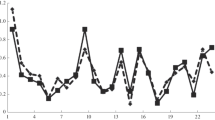Abstract
Experimental data are presented to show that the spatial and temporal variability of the composition of river waters cannot be explained solely by the influence of sources and effluents of the substances and that there are additional significant factors that support or even initiate the dispersion of the concentration of pollutants here. This variation is reflected in the resources and the economic characteristics of the rivers; so identification of its reason is important. Thus, the hydrodynamic structure of the water flow is studied by analyzing the complete system of equations of fluid motion mechanics. The completed work allowed us to show that the elements of this structure are waves, vortices, and highly gradient layers (ligaments), presumably creating the described dispersion effect. Further investigation of the relationship of the precise hydrodynamic and hydrochemical structures of river waters will contribute to better understanding of the water-environmental processes, ensuring the perfection of water management methods.


Similar content being viewed by others
REFERENCES
Rivers and Lakes of the World, Ed. by V. I. Danilov-Danil’yan (Entsiklopediya, Moscow, 2012) [in Russian].
https:/www.tripadvisor.ru/ShowUserReviews-g303235-d554183-r229755948.
O. M. Rozental and A. I. Averbush, Water Resour. 40 (4), 447–461 (2013).
S. Grill, V. S. Zykov, and S. C. Muller, Phys. Rev. Lett. 75 (18), 3368–3371 (1995).
F. Rossi, V. K. Vanag, and I. R. Epstein, Chemistry 17 (7), 2138–2145 (2013).
M. J. Hou and D. O. Shah, Langmuir 3, 1086–1096 (1987).
A. V. Anikeenko, G. G. Malenkov, and Yu. I. Naberukhin, J. Chem. Phys. 148 (9), 1660–1662 (2018).
A. V. Anikeenko and Yu. I. Naberukhin, JETP Lett. 106 (5), 290–294 (2017).
V. Yu. Zitserman, Yu. A. Makhnovskii, L. I. Trakhtenberg, et al., JETP Lett. 105 (5), 335–340 (2017).
Yu. D. Chashechkin, in Mathematical Modeling and Optimization of Complex Structures, Vol. 40 of Computational Methods in Applied Sciences (Springer 2016), pp. 61–91.
A. Sommerfeld, Lectures on Theoretical Physics, Vol. 5: Thermodynamics and Statistical Mechanics (Acad. Press, New York, 1956).
L. D. Landau and E. M. Lifshits, Course of Theoretical Physics, Vol. 6: Fluid Mechanics (Pergamon Press, Oxford, 1987).
Yu. I. Sukharev and B. A. Markov, Liesegang Opetrator. Liesegang Rings as the Common Gross–Property of Oxyhydrate Gel Polymer System. http://preprint.chemweb.com/physchem/0104005.
Author information
Authors and Affiliations
Corresponding author
Additional information
Translated by Z. Litvinenko
Rights and permissions
About this article
Cite this article
Chashechkin, Y.D., Rosenthal, O.M. The Physical Nature of Heterogeneity of the Composition of River Water. Dokl. Earth Sc. 484, 194–197 (2019). https://doi.org/10.1134/S1028334X19020107
Received:
Published:
Issue Date:
DOI: https://doi.org/10.1134/S1028334X19020107




